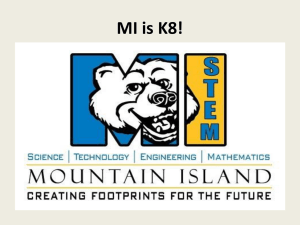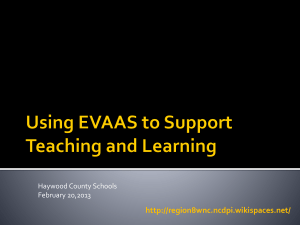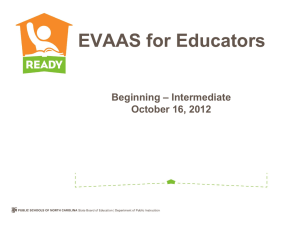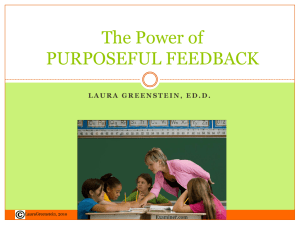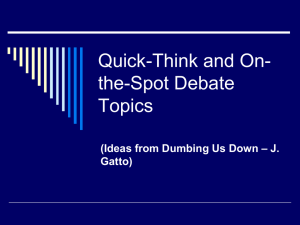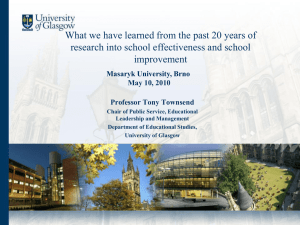Becoming “Distinguished” with High Expectations
advertisement
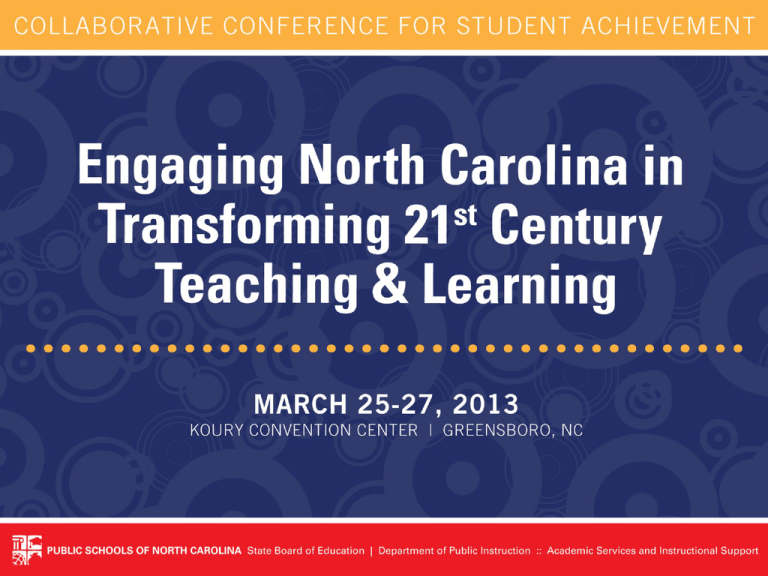
Becoming “Distinguished” with High Expectations Joyce B. Gardner, M.Ed., MSA. Professional Development Consultant Western Region (8) joyce.gardner@dpi.nc.gov 2 Becoming “Distinguished” with High Expectations Presentation and resources for this session are posted here: http://region8wnc.ncdpi.wikispaces.net/ Joyce Gardner Professional Development Consultant Western Region(8) joyce.gardner@dpi.nc.gov 3 Norms for Participation • Silence mobile devices. • Agree to consider and explore the perspectives of others. • Participate and engage with others in the session to maximize learning. • Share your ideas. Perspective Whether you think you can or whether you think you can't, you're right." -Henry Ford 5 Business, Norms, Evaluations • Please complete evaluations at the end of each session using the QR code in the conference booklet or go to http://bit.ly/VC1TTu • We do have a few paper evaluation forms that must be collected at the end of the session. Outcomes • Identify the impact of the beliefs about who can learn. • Describe the impact of high expectations for student learning. • Explore 21st century strategies to create a culture of high expectations. • Identify expectations for teachers meeting students’ needs in the NC Professional Educator Standards. Affinity Diagram Individually • Consider the challenges/issues with teaching the Common Core and Essential Standards to all students. • Write one thought that comes to mind per sticky note. Affinity Diagram • Combine all sticky notes on the table • Organize similar ideas. • Label the categories. • Identify two/three major ideas that emerged. The Power of What We Think Running alongside our visible and expressed values is a competing set of values we’re unaware of. Robert Kegan I can only change how I act if I stay aware of my beliefs and assumptions. Margaret Wheatley • How do we arrive at our expectations for students or colleagues, teachers, administrators? What are your beliefs? • All students can learn. • All students can learn if…? The Power of What We Think Running alongside our visible and expressed values is a competing set of values we’re unaware of. Robert Kegan I can only change how I act if I stay aware of my beliefs and assumptions. Margaret Wheatley The Five Whys: The Root Cause Ross, 2001 The Five Whys: The Root Cause Five Whys: Try it. What do you see? If someone meets or exceeds our expectations… How do we feel? How do we react? If someone does not meet our expectations… How do we feel? How do we react? Rick Wormeli on Differentiation “Differentiated instruction does not mean we make learning easier for students. Instead it provides appropriate challenge that enables students to thrive. Because we know our students so well, we know what buttons to push”. . Rick Wormeli on Differentiation “We teach in a responsive manner. When we teach in a way a student’s mind best processes information and skills, he or she finds the lessons compelling”. Rick Wormeli, Fair Isn’t Always Equal . Effects of Feedback “Success-oriented students tend to be encouraged by challenges because they anticipate the positive feelings that accompany success. Failure-avoidant students tend to be discouraged by challenges because they anticipate the negative feelings that accompany failure”. Robert Marzano, Classroom Assessment and Grading that Work, p.7, 2006 Self-fulfilling Prophecy • Robert Rosenthal • 18 classrooms • 20% of students were labeled “intellectual bloomers” after an “IQ” test. • Expectations were set that these students would main significant gains in this one year. Pygmalion Effect • Irish author George Bernard Shaw, wrote the play in 1913. • "My Fair Lady“, the musical (1956) and film (1964) made share a basic storyline, in which poor flower girl Eliza Doolittle is transformed into a lady at the hands of phonetics professor Henry Higgins. Pygmalion Effect applied to Teaching and Learning Low and high expectations are communicated through: – Teacher-student interaction – Levels of and frequency of questioning – Quality of verbal and written feedback – Cues and sustained support to guide students to develop their thinking and responses to questions Perceptions and Assumptions make an impact Teachers who were confident that their students could grow, improve, and learn and were confident that they had the skills to teach them with success saw their students respond accordingly. Perceptions On the hand, teachers who were not confident in their students’ potential to thrive and learn or in their abilities to teach them well had negative results. Updated and Confirmed • Wood, Kaplan and McLloyd confirmed this deferential treatment can result in an increase in IQ (2007) • The expectations teachers reflected on their students resulted in matching early expectations to a growing reality. ALL students achieving at high levels Why We Can’t How We Can X 28 Goals Setting If students are involved in setting goals and short- or medium-term targets for success criteria that they believe will help them reach their goals, then their predictions and achievement is very likely to be higher. John Hattie, Visible Learning, Carol Dweck’s work on Fostering a Growth Mindset Self-Theories: “...many students see their intelligence – and consequently their future achievement – as a fixed entity (Fixed Mindset), rather than something that can grow and develop (Growth Mindset). John Hattie, Visible Learning, Growth Mindset If teachers and students work together to adopt a Growth Mindset, then the selffulfilling low expectations of students (and teachers) can be raised, sometimes dramatically. John Hattie, Visible Learning, Understanding by Design How do teachers communicate expectations? • Seating, grouping • Attention, feedback • Questioning, fewer cues, sustained feedback • Criticism, lack of positive reinforcement • Quality & Rigor of tasks assigned Importance of Relationships • A relationship that conveys high expectations to students can internalize these beliefs in students and by doing so, develop the self-esteem and self-efficacy that Rutter found in the successful schools in his study. MetLife Survey of the American Teacher Interviews conducted October 4 –November 11, 2010 •1000 public school teachers, grades 6‐12 (Telephone interviews) •2002 public school students, grades 6‐12 (Online interviews) •580 parents of public school students in grades 6‐12 (Online interviews) •21 public school teacher leaders and public education thought leaders •301 business executives from Fortune 1000 companies in online interviews MetLife Survey of the American Teacher: Results Impacts on Student Achievement Teachers Principals High expectations for all 86% 89% Core reading, writing and math skills 90% 92% Real world connections with all content 80% 80% We have the knowledge and skills needed for students to succeed. 84% NA Common Core? • Comparatively fewer educators, however, are confident that the Common Core will improve student achievement and better prepare students for college and the workforce. Knowledge = Confidence • Among educators overall who are more knowledgeable of the Common Core, and in schools where teachers are reporting using the standards a great deal in their teaching, there is a greater level of confidence that the standards will improve student achievement. MetLife Survey of the American Teacher – from Learning Forward • Core skills and high expectations are seen as critical to improving student achievement. (2009) However, • Gaps exist between the beliefs of teachers in the important role of high expectations in academic achievement and the extent to which they are communicated and demonstrated in practice for all students. (2009) Learning Forward • Answers the question of how effective a schooling experience is for learners • Produces reports that – Predict student success – Show the effects of schooling at particular schools – Reveal patterns in subgroup performance What is EVAAS? End of Grade End of Course ACT Writing SAS EVAAS Analyses LOOKING BACK Evaluating Schooling Effectiveness: Value Added & Diagnostic Reports LOOKING AHEAD Planning for Students’ Needs: Student Projections to Future Tests Benefits and Considerations for Teachers • Understand academic preparedness of students before they enter the classroom. • Monitor student progress, ensuring growth opportunities for all students. • Modify curriculum, student support, and instructional strategies to address the needs of all students. Professional Development is the Key • Data Conversations / True PLCs • Culture of School • Sensitivity of Data • Finger Pointing and Blame Game • Window vs. Mirror 44 How do you explain the concept of Achievement vs. Growth? Student Achievement Proficient End of School Year Student Growth Proficient Not Proficient Start of School Year End of School Year Achievement vs. Growth Student Achievement: Where are we? • Highly correlated with demographic factors Student Growth: How far have we come? • Highly dependent on what happens as a result of schooling rather than on demographic factors The EVAAS Philosophy • All students deserve opportunities to make appropriate academic progress every year. • There is no “one size fits all” way of educating students who enter a class at different levels of academic achievement. The EVAAS Philosophy • Adjustments to instruction should be based on the students’ academic needs, not on socio-economic factors. • "What teachers know and can do is the most important influence on what students learn." (National Commission on Teaching and America's Future, 1996) Achievement and Poverty How is this fair? Academic Growth and Poverty No one is doomed to failure. High-Achieving Students and Progress All schools in Tennessee in 2011 - Math students in grades 4 through 8. Districts, schools, and teachers that serve high achieving students can make excellent progress, just as easily as those that serve low achieving students. Proficiency vs. Growth Scenario 5th grader begins the year reading at a 1st grade level. Ends the year reading at a 4th grade level. 5th grader begins the year reading at a 7th grade level. Ends the year reading at the 7th grade level. Proficient Growth NO YES YES NO Table Talk • How could you use the concept of achievement vs. growth to discuss high expectations with teachers? • How does the achievement vs. growth conversation guide PLCs? How can EVAAS help me? EVAAS: Looking Back Past Program Effectiveness EVAAS: Looking Ahead Incoming Student Needs Improve the Education Program Local Knowledge & Expertise Academic at Risk Reports Be Proactive Use these reports for discussing, developing and implementing targeted intervention and support to students who are at risk for not meeting future academic milestones. 57 Making Data Driven Decisions What Are Projections Anyway? Given a specific set of circumstances… …what’s the most likely outcome? What Are Projections Anyway? Given this student’s testing history, across subjects… …what is the student likely to score on an upcoming test, assuming the student has the average schooling experience? EVAAS Projections What are they based on? Expectations based on what we know • About this student and other students who have already taken this test • Prior test scores (EOC/EOG), across subjects • Their scores on the test we’re projecting to What’s the Value of the Projections? Projections are NOT about predicting the future. They ARE about assessing students’ academic needs TODAY. Assessing Students’ Needs • What are this student’s chances for success? • What goals should we have for this student this year? • What goals should we have for this student in future years? What can I do to help this student get there? Using Projections to Take Action • Identify students • Assess the level of risk • Plan schedules • Identify high-achievers • Assess the opportunities • Inform Reflect on Past Effectiveness to Plan for Differentiating Student Instruction Past Effectiveness Entering Achievement Academic Preparedness Report 66 Achievement vs. Progress Student Progress – How far have I come? • Highly dependent on what happens as a result of schooling rather than on demographic factors. Achievement vs. Progress • Focus on progress • Educators can influence this • Minimum expectation = one year of academic gain EVAAS can tell you WHAT happened. It’s up to YOU to determine WHY it happened and what you want to do about it. Local Knowledge & Expertise EVAAS Improve the Education Program Thinking about Expectations •Using implicit attitude assessments to identify "inflexible perceptions" about student ability. •Teach pre-service teachers about the "risks of inequitable expectations" and offering training to amend negative perceptions. •Track teachers' interactions with students and provide PD for improvement Thinking about Expectations •Adopt teacher evaluation systems that measure expectations and perceptions of students. •Ensure PD around the Common Core State Standards that emphasizes the need for high expectations paired with the high standards. Expert Teachers- John Hattie Differ from experienced teachers – -the way they represent their classrooms, -the degree of challenges that they present to students, and most critically, -in the depth of processing that their students attain. Expert Teachers with High Expectations • Students who are taught by expert teachers exhibit an understanding of the concepts targeted in instruction that is more integrated, more coherent, and at a higher level of abstraction than the understanding achieved by other students. Difference between Experienced and Expert Teachers • Challenge • Deep Representation • Monitoring and Feedback John Hattie Ron Edmonds, “Effective Schools” research We can whenever, and wherever we choose, successfully teach all children whose schooling is of interest to us. We already know more than we need, in order to do this. Whether we do it must finally depend on how we feel about the fact that we haven’t so far.” “Some Schools Work and more Can” speech, 1978 Effective Schools Beliefs 1. All children can learn & come to school motivated to do so 2. Schools control enough of the variables to assure that virtually all students do learn 3. Schools should be held accountable for measured student achievement Effective Schools Belief #4 Schools should disaggregate measured student achievement to be certain that students, regardless of gender, race, ethnicity, or socioeconomic status, are successfully learning the intended school curriculum. Effective Schools Belief #5 The internal & external stakeholders are the most qualified & capable people to plan & implement the changes necessary to fulfill the “learning for all” mission. Reflection How are high and low expectations revealed in the classroom? Educator Evaluation Standards • Scavenger Hunt: Search for elements related to high expectations for student learning and how this might be observed. • Enter examples at http://padlet.com/wall/ 6ggtourh66 NC Professional Teaching Standards Standard I: Teachers demonstrate leadership. • Take responsibility for the progress of all students • Use data to organize, plan, and set goals • Use a variety of assessment data throughout the year to evaluate progress • Analyze data Standard IV: Teachers facilitate learning for their students. • Use data for short and long range planning Standard V: Teachers are reflective on their practice. • Collect and analyze student performance data to improve effectiveness Force Field Analysis Climate of High Expectations Staff • believe & demonstrate that all students can obtain mastery of the school’s essential curriculum. • believe that they, the staff, have the capability to help all students obtain that mastery Climate of High Expectations • High Standards are set for all students to meet • Expectations are the internal belief systems of the adults in the schools • All teachers believe that kids can and will meet those higher standards. Rate Your School/District • Do teachers and principals demonstrate high expectations for themselves and students? • What are some observable and measurable indicators of schools having high expectations? Force Field Analysis Strategies to Raise Expectations and Hope for all Students Do you Believe in Me? “I can do anything… be anything … create anything … dream anything … become anything … because you believe in me.” From a speech delivered by Dalton Sherman, age 10 The Power of What We Think Begin challenging your own assumptions. Your assumptions are your windows on the world. Scrub them off every once in awhile, or the light won't come in. – Alan Alda Evaluations • Please complete evaluations at the end of each session using the QR code in the conference booklet or go to http://bit.ly/VC1TTu • There are a few paper evaluation forms available and these must be collected at the end of the session. • Hattie, J. A. (1992a). Towards a model of schooling: A synthesis of meta-analyses. Australian Journal of Education, 36, 5–13. • Hattie, J. A. (1993a). Measuring the effects of schooling. SET, 2, 1–4.

